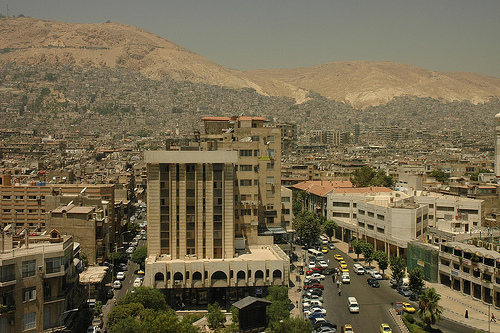Many foreigners are coming to Damascus to live its oriental atmosphere, touch its glorious past in Damascus castle, feel its magnificent architecture in Damascene palaces, sense God’s Almighty in its divine mosques and churches.
Some of them are travelers or have served their country in Damascus, were seduced by the Levant. For instance, Fernando Aranda whose father was a musician working in the palace of Sultan Abdul Hamid in the Sublime Porte came in 1903 and served as Honorary Consul for thirty years. At the same time he was an architect, he designed the Hijaz Railway Station and hotel of Zenobia, and wrote a lot about political and diplomatic relations between Syria and Spain. Others, like orientalists have authored books with photographs and information about Middle East and Damascus, some of them are still used as a reference until today. Another visitors category those who have come to Syria based on a preconceived idea in order to enjoy nature and beauty, or to discern its ancient civilization, like tourist groups coming through Syrian assistance for tourism and traveling office.
We met one of those groups, they were from various nationalities from Arab and foreign countries such as Egypt, America, Australia, and Malaysia. The aim of this visit was to see Old Damascus including churches, mosques, and different relics.
The group came overland from Lebanon, as a bus has been sent to Syrian – Lebanese borders in the early morning, hoping to reach the old Damascus and have a breakfast in one of the restaurants.
The round began by Bab Sharqi, but Mr. Hani Tawfik desire, one of the touristic group, was from the outset to know old Damascus history and modern markets, by declaring: “I heard a lot about souks and bazars in Syria where you can find inexpensive hand-made goods”. Therefore, pace began from the east door of Damascus through the church of Ananias Navlin and his waif Marilyn. An Australian couple was surprised by the amusing and busy atmosphere of Hamidiya souk with its iron covered ceiling full of small holes where the sun comes though during daylight, and its black basalt paved lanes, without mentioning tourists and visitors everywhere from all parts of the world. Where shops, antique boutiques, stands are lined on both sides, as tourist and buyers bargain with shop-owners to buy hand-made products like crafted carpets, copper lanterns and mosaic wooden boxes. Those shops along with other ones vending household items, Arabian sweets and cotton outfits. “It’s a commercial industrial city in the heart of Old Damascus” remarked Leon from Malaysia. An old musical instrument called “Rababa” (a kind of flute made of cane), have had the largest share of the time. It was a long pause in front of the vendor who was playing on the musical instrument, as Nevin Habib the Egyptian lady asked about the price and usage of that instrument, because she wanted to buy as a memorial gift for her children from Syria.
Whereas what raised Javiar Cardinal curiosity, was traditional productions such as copper manufactures, arabesques, cotton fabrics and garments, silk embroiderers, brocade upholstery, carpets, and golden antiques and gifts.
While Helen suggested “ One day is not enough to see relics and markets, since we had no prevision about Syria, as we were in Lebanon and abruptly decided to go down to Syria. So let’s consider our experience only a discovery trip, and come again on a prolonged journey to enjoy and explore this country treasures.
We had lunch in an Oriental restaurant famous for its Halaby-cuisine. The Tour guide recommended barbecue and Kebab as main course, since the group members are from different nationalities, to fit everyone’s taste. it was enjoyable to look at tourists exploring oriental appetizers from hummus, to baba ghanoush, tabbouleh to fattoush. Bon appetite, and come back again.
Haifaa Mafalani

